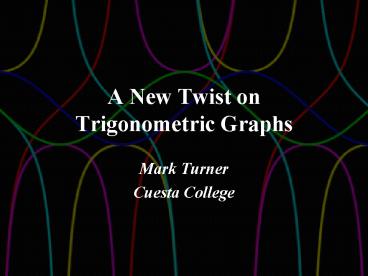A New Twist on Trigonometric Graphs - PowerPoint PPT Presentation
1 / 24
Title:
A New Twist on Trigonometric Graphs
Description:
Plot a few anchor points. Sketch the graph and extend as necessary ... Plot the anchor points and sketch any asymptotes (don't forget to check for a ... – PowerPoint PPT presentation
Number of Views:163
Avg rating:3.0/5.0
Title: A New Twist on Trigonometric Graphs
1
A New Twist onTrigonometric Graphs
- Mark Turner
- Cuesta College
2
ISSUE
- How can we simplify the process of graphing the
six trigonometric functions for our students?
3
My Solution
- Use consistent definitions of the six basic cycles
- Construct a simple frame for one cycle
- Plot a few anchor points
- Sketch the graph and extend as necessary
4
First, we will use some interactive java
applications to derive the basic cycles for the
circular functions.I created these applets
using which is free and very user friendly.
5
GeoGebra Applets
Internet Link
6
THE BASIC CYCLES
- y sin(x)
- y cos(x)
7
THE BASIC CYCLES
- y csc(x)
- y sec(x)
8
THE BASIC CYCLES
- y tan(x)
- y cot(x)
9
What are the advantages of using these
definitions?
10
1. CONSISTENCY
- All six basic cycles begin at zero
- By knowing the period, students know the cycle
interval
11
2. LESS CONFUSION
- Because the graphs all look different, it is not
as easy to confuse one for the other
- The phase shift is easier to identify
12
What are some possible disadvantages of using
these definitions?
13
- Visualizing the inverse tangent graph
(though this does not appear to be an issue with
the sine function)
- Most textbooks do not use these definitions
14
Step-by-StepProcess
15
Find the vertical translation and draw a
horizontal line (lightly) at this value. Pretend
this is now the x-axis.
- Find the amplitude A. Lightly draw horizontal
lines A units above and below the translated
x-axis. This gives us the upper and lower sides
of the frame.
16
- Solve the compound inequality
- or
- for the variable x.
17
After solving
- the left value is the phase shift, and indicates
where a cycle begins - the right value indicates where a cycle ends
- the difference of the two values is the period
18
Find the period and divide it by four. Set the
scale on your x-axis so that this value is equal
to some whole number multiple of squares (like 2).
19
Lightly draw vertical lines where the cycle
begins and ends. These lines form the left and
right sides of the frame.
20
- Subdivide the frame (lengthwise) into four equal
sections. To label the three intermediary points,
start at the left edge of the frame and add
one-fourth the period. Repeat two times.
21
Within the frame, sketch the graph of a complete
cycle through the anchor points.
- Plot the anchor points and sketch any asymptotes
(dont forget to check for a reflection and
adjust the anchor points accordingly).
22
- Extend the graph by duplicating the cycle as
necessary
- To verify on a graphing calculator, use the frame
to help set up an appropriate window.
23
EXAMPLES
24
CommentsorQuestions?































